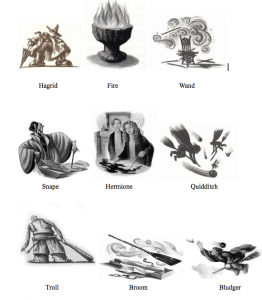Five Tips for Teaching “Harry Potter” to Struggling Readers
As the school year starts again, I’m sure many fans who are teachers, parents, and mentors want to share the joy of Harry Potter with young readers. Unfortunately, the Harry Potter series can be a challenge for struggling readers because of its length, complicated names, unfamiliar vocabulary, and intricate plots. This past year I started a Harry Potter book club for 4th and 5th graders at an after school program for girls from underserved communities. Many of the girls I worked with had never even heard of Harry Potter before and didn’t have experience with chapter books of that length. Doing this club required a lot of experimenting in order to keep my students engaged with a text that they found challenging and confusing, and some of my solutions definitely worked better than others. Here are the top tips I gained from this experience:
1. Audiobooks and Bingo
Pretty early in my club experience, I realized that reading out loud was not going to be a successful method of getting through the book. Every page took my students several minutes, and meanwhile, everyone else was getting antsy and losing interest. Luckily, I had access to the Harry Potter audiobooks by Jim Dale, which provided a welcome break from reading for my girls. The stories came alive with Jim Dale’s entertaining voices, and we began to gain ground in the books.
One problem that came up, however, was that my students began to space out during the audiobooks. As a solution to this issue, I created Harry Potter bingo cards with words that commonly came up in the chapters we listened to. When my students heard one of the words in the audiobook, they could mark it off on their bingo cards, and when they got a bingo they would get a Bertie Bott’s Every Flavor Bean. This strategy motivated and reminded them to pay attention to what was happening in the story.

2. Pottermore
As we got further into the story, Pottermore’s quizzes provided a great resource for my students to feel personally connected to the books. When Harry gets his wand from Ollivanders, I had my students take Pottermore’s wand quiz to see what wand chose them. They then got to pick out sticks that were the right size and flexibility to decorate as their own wands.
When Harry gets Sorted into his Hogwarts House, we all took the Pottermore Sorting quiz so that each girl could see which House she was in. Then we had our own real-life Sorting Ceremony (pro tip: put a phone or walkie talkie into a witch’s hat, and then a person in another room can pretend to be the Sorting Hat). Once the girls were Sorted, they started to feel a sense of ownership and belonging in the series.
3. Crafts
Harry Potter crafts were one of the most successful additions to our club sessions. The girls loved these simple crafts that brought the events of the books to life. For the first chapter, when owls are flying around the Muggle world, we made pom pom owls.

When Harry goes to Flourish and Blotts, we bound and decorated spellbooks. After getting Sorted, we cut out House pins and felt House ties. When Harry learns Quidditch, we made miniature brooms and Snitch necklaces. One of my favorite activities was the Mirror of Erised, which my students could decorate with a collage of the things they wanted most in the world:

The girls loved these crafts, and they were also memorable, so I could refer back to them in order to increase comprehension.
4. Movies
Although I would generally want kids to wait to watch the movies until after reading the books, strategically using scenes from the movies turned out to be an effective way of improving understanding. There were many scenes that were still confusing to my students after reading them or hearing them read out loud. Being able to see a dramatic representation of a key scene immediately made it easier for them to visualize the strange world and events being described to them.
5. Discussion Questions
Connecting events in the stories to their own lives was also a helpful way of increasing understanding and engagement. It was nice to have some lighter icebreaker questions (“If you could turn into an animal like McGonagall, what animal would you choose?”), but also some questions that would promote deeper conversation. For example, in the first chapter, we discussed the prompt: “Do you spend most of your time wanting to be normal, or wanting to be different? What can be scary about things being strange or unusual?” It was always interesting to hear about my students’ first impressions of each new character and who they liked and disliked and why.
There were many challenges to doing this club, and I certainly did not solve all the problems posed by trying to engage struggling readers with this series. However, even when they had difficulty understanding the books, my students always loved Harry Potter club, and that was a success in itself. I would love to hear any of your questions and suggestions on this issue in the comments below!

